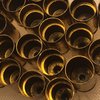manithree
Member
- Joined
- Sep 18, 2009
- Messages
- 112
Pushing on the muzzle to disassemble is a bigger turn-off for me than pulling the trigger. That just gave me some serious heeby jeebies. But it is an interesting design in spite of my experience-based (but not scientifically informed) aversion to blowback actions.
Great work! I don't mean to be too negative, either. That's an amazing accomplishment.
Great work! I don't mean to be too negative, either. That's an amazing accomplishment.




